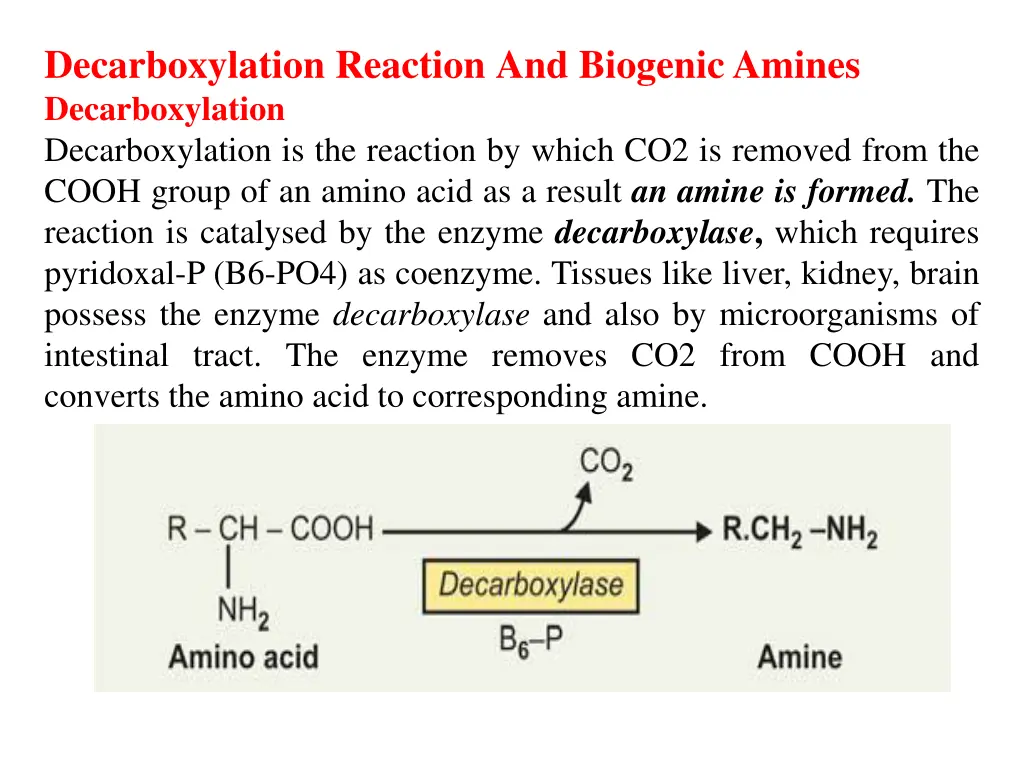
Decarboxylation Reaction and Biogenic Amines in Amino Acid Metabolism
Explore the process of decarboxylation in amino acids, leading to the formation of biogenic amines like tyramine, tryptamine, and histamine. Discover the metabolic fate of aromatic amino acids and the significance of phenylalanine and tyrosine in the body. Learn about essential and non-essential amino acids and their roles in biochemical pathways.
Download Presentation

Please find below an Image/Link to download the presentation.
The content on the website is provided AS IS for your information and personal use only. It may not be sold, licensed, or shared on other websites without obtaining consent from the author. If you encounter any issues during the download, it is possible that the publisher has removed the file from their server.
You are allowed to download the files provided on this website for personal or commercial use, subject to the condition that they are used lawfully. All files are the property of their respective owners.
The content on the website is provided AS IS for your information and personal use only. It may not be sold, licensed, or shared on other websites without obtaining consent from the author.
E N D
Presentation Transcript
Decarboxylation ReactionAnd Biogenic Amines Decarboxylation Decarboxylation is the reaction by which CO2 is removed from the COOH group of an amino acid as a result anamine is formed. The reaction is catalysed by the enzyme decarboxylase, which requires pyridoxal-P (B6-PO4) as coenzyme. Tissues like liver, kidney, brain possess the enzyme decarboxylase and also by microorganisms of intestinal tract. The enzyme removes CO2 from COOH and converts the amino acid to corresponding amine.
Some Of The Important Biogenic Amines 1. Tyramine Decarboxylation of tyrosine forms tyramine. This occurs in the gut as a result of bacterial action. Also this reaction takes place in kidney. The reaction isfavoured by O2-deficiency. In the presence of sufficient O2, tissue deaminates tyrosine. Tyramine elevates blood pressure.
2. Tryptamine Mammalian kidney, liver and bacteria of gut can decarboxylate the amino acid, tryptophan to form the amine tryptamine. Tryptamine also elevates blood pressure. Hydroxylation at 5-position produces 5-OH- tryptamine- 5-HT (Serotonin).
3-Histamine Histamine is formed by decarboxylation of amino acid Histidine by the enzyme Histidine decarboxylase or aromatic L-amino acid decarboxylase in presence of B6- PO4.
Metabolism of Individual Amino Acids A-Metabolism of Aromatic amino acids
Points to remember Phenyl alanine is an essential amino acid, while tyrosine is not essential, as it can be formed in the body from phenyl alanine. In phenyl ketonuric patient, where phenyl alanine cannot be converted to tyrosine in the body due to inherited deficiency of the enzyme, tyrosine becomes essential amino acid to the patient. Both can participate in transamination reaction. Both amino acids are 'glucogenic' and 'ketogenic'. Note: -Amino acids which give rise to pyruvic acid or one of the intermediates of Krebs cycle are glucogenic. -Amino acids which give acetyl CoA are Ketogenic amino acids. Leucine and lysine are the only pure ketogenic amino acids
A- Metabolic Fate: (1) Conversion of phenyl alanine to tyrosine. The reaction involves hydroxylation of phenyl alanine at p-position in benzene ring by phenyl alanine hydroxylase which present in the liver. The enzyme requires coenzymes and cofactors for its activity: Molecular oxygen, NADPH, Fe++ and Ptreidine (folic acid) coenzyme: Tetrahydrobiopterin- FH4].
(2) Metabolic Fate of Tyrosine. 1-Tyrosine is degraded to produce as end products fumarate and acetoacetate. 2-Fumarate is glucogenic, whereas acetoacetate is ketogenic. 3-Phenyl alanine is catabolized via tyrosine. Hence both phenyl alanine and tyrosine are glucogenic and ketogenic.
B-Metabolic Role of Tyrosine: Tyrosine though it is non- essential, but it is of great importance in human body. Many biological compounds of importance are synthesized from tyrosine like: 1 -Synthesis of thyroid hormones: Thyroxine (T4) and tri-iodo thyroxine(T3). 2-Synthesis of catecholamine s: epinephrine (adrenaline) , nor epinephrine (nor-adrenaline) and dopamine. All three are synthesized from tyrosine and acts as "neurotransmitters"
3- Synthesis of melanin pigment: Melanins are synthesized from tyrosine in " melanosomes", membrane bound particles within melanocytes in skin which are cells of neural crest origin. Melanins function is to protect underlying cells from the harmful effects of sunlight. Types of melanins:(depending on physical and chemical properties) Eumelanins Pheomelanins:They contain sulphur. Trichochromes: contains sulphur pheomelanins. and are related to
4 - Formation of tyramine 5- Formation of phenol and cresol: phenylalanine and tyrosine are acted upon by intestinal bacteria in the gut to form p-cresol and phenol. 6 - Formation of tyrosine-O-sulphate: this is present in fibrinogen molecule.
Clinical aspect: Inherited Disorders Following disorders are associated with phenylalanine and tyrosine metabolism. 1-Phenyl Ketonuria 2- Albinism 3- Tyrosinaemia Type I 4-Tyrosinaemia Type II 5- Neonatal Tyrosinaemia 6-Hereditary Tyrosinaemia 7- Alkaptonuria
Phenyl Ketonuria(PKU) Six types of hyper phenylalaninaemia have been described
Accumulation of phenylalanine leads to: - Defective "serotonin " formation. - Also impairs melanin synthesis, children with the defect tend to have flair skin and fair hair. -Excess of phenyl alanine in blood leads to excretion of this amino acid into the intestine. Here it competes with tryptophan for absorption. Tryptophan becomes subject to action of intestinal bacteria resulting in formation of indole derivatives which are absorbed and excreted in urine.
Clinical Features: Child is mentally retarded, other features include seizures, psychoses, eczema, failure to walk or talk, hyperactivity, tremor, and failure to grow. Blood: increased levels of phenyl alanine. Normal level in blood is 1- 2 mg%. It increases to 15-65 mg%. Urine: - excretion of phenyl alanine, and its catabolites: phenyl pyruvic acid, and phenyl actic acid. -phenyl acetic acid excreted as phenyl acetyl glutamine which produces "mousy odour". - also abnormal O-hydroxy derivative is formed, whose metabolites may also be found in urine.
Treatment: - by giving diet having low levels of phenyl alanine, supplemented with some natural foods (such as fruits, vegetables, and certain cereals) selected for their low phenylalanine content. -Treatment must begin during the first (7-10) days of life to prevent mental retardation. -Tyrosine must be supplied in the diet, because it cannot be synthesized from phenylalanine and therefore it becomes an essential amino acid.
2- Albinism Albinism refers to a group of conditions in which a defect in tyrosine metabolism results in a deficiency in the production of melanin( hypomelanosis). These defects result in partial or full absence of pigment from skin, hair and eyes. 3- Alkaptonuria: A rare inborn error or hereditary defect in metabolism of phenyl alanine and tyrosine. Enzyme deficiency: lack of the enzyme homogentisate oxidase resulting in the accumulation of homogentisic acid (one of many derivatives of tyrosine).






















